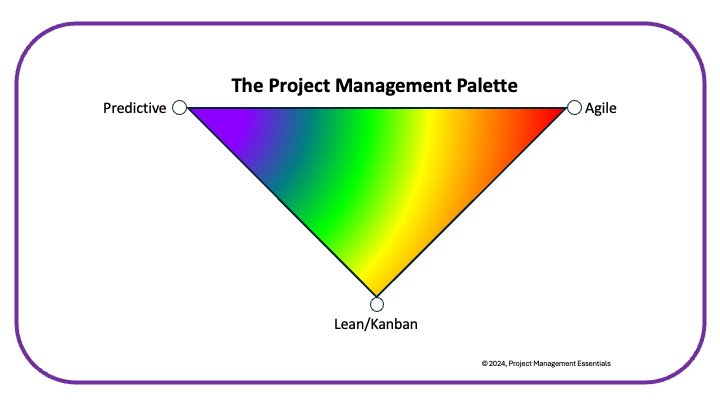We should view project management approaches as a palette of options. Predictive, Agile, and Lean/Kanban form the boundaries. Hybrid is the vast interior space. The first article in this series described the boundaries and color-mix of approaches:
- Predictive. The traditional, cascading, high-structured approach.
- Agile (Scrum). An adaptive approach with empowered, self-organizing teams.
- Lean/Kanban. Value-driven and flow-based principles that can be integrated into all approaches.
- Hybrid-Predictive. Mostly traditional structures with integrated agile practices.
- Hybrid-Agile. An adaptive approach tempered by traditional constraints.
This article discusses how these approaches may be reflected in central project management domains.
Project Phases
Contents
The project approach becomes a defining characteristic when describing the project phases and how they are executed.
Predicative follows a rigid, sequential approach. Gate reviews mark the completion of each phase.
Scrum is characterized by a series of design-build-test iterations (sprints), commonly two weeks long.
Hybrid-predictive projects follow the predictive structure. However, the phases may overlap. A typical pattern is the overlapping of design with development, and development with testing. Phase reviews may be informal or not used.
Hybrid-agile projects follow a scrum-like model but are subject to more traditional project constraints. Development is iterative, but testing may fall outside the sprints. Delivery may be at the end rather than incremental.
Scrum-fall is a hybrid pattern that follows a sequential approach through planning, requirements, and design but then uses the iterative approach during the build phase.
Kanban primarily focuses on the flow of work. Agile teams use a Kanban board to manage the progression of features and user stories. Predictive and hybrid teams can also use Kanban boards. They can be used to manage the flow of documentation or track development and testing activities.
The Problem Space
Predictive is optimized for simple and complicated problems with clearly defined requirements.
Scrum is designed to solve complex problems where the solution may not be immediately apparent. Additional information, feedback, and refinement are needed to understand the problem and design the solution space.
The flow-based Kanban approach readily supports simple and complicated problems because the process steps are well-defined and understood. The objective is to maximize value delivery with the shortest sustainable lead time.
Organizational preferences and other external considerations often guide the project approach decision. Organizations tend to use the prevailing approach regardless of the problem type.
Scope, Schedule, Cost, and Change
Predictive projects are characterized by a fixed scope, schedule, and cost. The classic triple constraint asserts that a change in scope requires a corresponding change in schedule or cost. Consequently, change is managed through a formal and structured process.
Agile projects flip the triple constraint. The scope is emergent, and time and cost can be fixed. The project timebox constrains scope. The product owner and stakeholders regularly review and reprioritize the required features. A lightweight process can be used to manage change.
Most organizations using hybrid approaches retain predictive’s fixed-scope mindset, which creates tensions with agile’s emergent scope. For many, abandoning the triple constraint is akin to questioning gravity. Hybrid-agile struggles to reconcile the Agile Manifesto’s “embracing change” principle with a fixed mindset.
Stakeholder Engagement
Traditional predictive projects have limited stakeholder engagement. Engagement is high when requirements are collected and during user testing and transition phases. Engagement is light and generally confined to status updates during the execution phases.
Agile values regular and consistent stakeholder engagement. The Manifesto embraces “customer collaboration.” The product owner is the voice of the customers and is embedded with the development team.
Hybrid-predictive projects involve more frequent stakeholder engagement, a pattern that has existed since the advent of waterfall. Joint application design (JAD) and other practices were developed to engage stakeholders in the solution and provide early feedback.
Hybrid-agile projects embrace the principles of regular engagement. In practice, several challenges often arise:
- Traditional requirements documents are written and translated into user stories, reducing customer-developer collaboration on the solution.
- The product owner lacks the necessary skills or experience for this critical role.
- Customers are not sufficiently engaged in the user demonstrations and conduct acceptance testing at the end.
Management Approach
The traditional, top-down, command-and-control management approach is associated with predictive projects. The project manager is accountable for the project’s success and leads the team. They are empowered to make decisions, assign tasks, and manage the execution of the project work.
Agile takes a decidedly different approach to management. Agile teams are self-organizing. The scrum master is a facilitator and servant leader whose primary role is helping the team and organization mature. A Scaled Agile principle is “unlocking the intrinsic motivation of knowledge workers.
Douglas MacGregor’s Theory X and Y embodies the predictive versus agile approaches dichotomy. Theory X managers characterize the traditional industrial model, where workers are not to be trusted. Management’s role is to provide oversight and control. Theory Y managers are the antithesis. People want to do a good job, and the role of management is to create an environment where people can succeed.
The management approach for hybrid projects often depends on external factors. The design phase of a construction project may seek to unlock creative energies, while the build phase may focus on adherence to the plan. Culture, team structure, and individual personalities also play an essential role. I have observed participative leaders in predictive projects and autocratic ones in agile projects.
Process and Documentation
Predictive projects require significant documentation and strict process adherence. The approach evolved from construction projects, where the cost of change is high. Detailed design specifications are necessary and are the primary means for conveying information. Regulatory or internal organizational standards may also be important considerations.
Agile evolved from software development, where the cost of change is low. Small, multidisciplinary teams can effectively develop solutions to complex problems. Consequently, the Agile Manifesto challenged the need for “excessive documentation” and valued “individuals and interactions over processes and tools.”
Agile does not reject all documentation or processes. It has adopted a “minimally sufficient” standard, which means selecting the appropriate level of process and documentation required for a project. A large, geographically dispersed team developing a life-critical system requires more control than a small, co-located team building a non-critical application.
Hybrid projects must establish pragmatic and context-sensitive processes and documentation (borrowing from Disciplined Agile). The principles of Lean and Kanban can guide this process, eliminating waste and delivering value with the shortest sustainable lead time.
Hybrid-agile projects often face external constraints, such as contractual, regulatory, or organizational requirements—for example, agile software development on a government project. Contractual constraints may require more documentation, out-of-sprint acceptance testing, or a more structured change management process.
© 2024, Alan Zucker; Project Management Essentials, LLC
See related articles:
- Hybrid Project Management, Part 1: What is Hybrid?
- Peter Drucker: The Father of Agilism
- Taylorism: Then & Now
- The Evolving Arc of Management
To learn more about our training and consulting services or subscribe to our newsletter, visit our website: https://www.pmessentials.us/.

